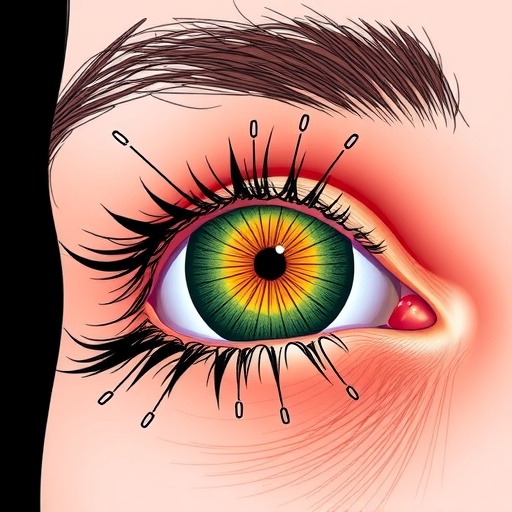Emerging research in the field of ophthalmology has recently spotlighted the intricate functions of the lower eyelid musculature, particularly focusing on the orbicularis oculi. A groundbreaking study by Krajewska-Węglewicz and Dorobek, published in the journal Scientific Reports, delves into the electromyographic aspects of lower eyelid muscle function within patients suffering from ptosis – a condition that results in drooping eyelids. The study is poised to reshape our understanding of eyelid mechanics and their aesthetic implications, especially concerning scleral show, which is defined as an excessive visibility of the sclera in a relaxed state of the upper eyelid.
This research ventured into uncharted territories by applying surface electromyography (sEMG) to assess the orbicularis oculi’s role in eyelid dynamics. The significance of accurately measuring muscle activity cannot be understated, as it elucidates how dysfunction in these muscles can lead to aesthetic concerns, particularly in individuals with ptosis. The researchers aimed to determine the relationship between eyelid position and the electrical activity of the underlying muscles during both rest and voluntary closure.
A notable aspect of this study involved the unique challenges posed by ptosis. Traditional techniques for evaluating eyelid function often fall short in accurately portraying the complexities of muscle dynamics and the resulting visual effects. The authors advocated that by incorporating sEMG technology, a more precise measurement can be attained. This innovative method captures the electrical signals produced by the muscles, revealing not just whether the muscle is active, but to what extent it is engaged in performing its physiological role.
The findings from this study shine a light on a frequently overlooked element of facial aesthetics—the droopiness of the lower eyelid associated with muscle dysfunction. The orbicularis oculi, which encircles the eye, is fundamental in controlling not just eyelid closure but also the overall balance of the ocular region. The paper emphasizes the connection between the functional activity of this muscle group and the visual perception of eyelid position, especially concerning patients presenting with noticeable scleral exposure when the eyelid is at rest.
Moreover, the implications of this research extend beyond the aesthetic realm. Poor functioning of the lower eyelid muscles can lead to complications such as exposure keratopathy, where the cornea becomes damaged due to inadequate eyelid coverage. This highlights the critical nature of skeletal musculature function about ocular health, requiring clinicians to take a multifaceted approach when treating ptosis. Krajewska-Węglewicz and Dorobek’s investigational approach seeks to bridge the gap between clinical practice and research, promoting a better understanding of how muscle dynamics can inform treatment pathways.
In their study, the methodology employed an advanced sEMG system to record the electrical activity of the orbicularis oculi while simultaneously capturing high-resolution images of the eyelid position. This dual approach allows for a comprehensive analysis that reveals both the muscle’s condition and its functional manifestations in real time. The outcome data suggests a strong correlation between decreased electrical activity and greater levels of scleral show, reinforcing the hypothesis that the health of the orbicularis oculi directly influences both ocular exposure and the cosmetic appearance of the eyelids.
The authors also investigated variability within their cohort, exploring how factors such as age, sex, and severity of ptosis impacted muscle function. Their results indicate that there is a notably diverse response among patients, emphasizing the importance of individualized assessment and treatment planning. A one-size-fits-all strategy for managing ptosis may not be effective, and understanding these variances could lead to more tailored, efficacious interventions that account for the specific needs of each patient.
Of particular interest to surgeons and aesthetic medical professionals, the study sets a precedent for utilizing sEMG as a diagnostic tool in clinical settings. The ability to quantify muscle function could transform pre-operative assessments and inform surgical decisions. For example, deciding the extent of surgical intervention required to correct ptosis may be influenced by detailed sEMG readings that elucidate the functional capabilities of the eyelid muscles.
The cosmetic implications of this research cannot be overlooked. As patients become increasingly conscious of the aesthetics of their eyes, understanding the nuances of eyelid function becomes essential for enhancing patient satisfaction. Surgeons may find this information invaluable in consultations, allowing them to set realistic expectations and refine techniques that directly address the specific manifestations of ptosis observed through sEMG data.
In summary, Krajewska-Węglewicz and Dorobek’s publication ushers in a new era of understanding regarding eyelid musculature and its impact on both ocular health and aesthetic perception. By employing sophisticated technology such as surface electromyography, the researchers have developed a compelling case for the crucial role of the orbicularis oculi in managing ptosis and consequent scleral show. Their work paves the way for further investigations and potential therapeutic innovations, underscoring the ever-evolving landscape of ophthalmic research. As the findings proliferate throughout the scientific community, they will undoubtedly prompt further inquiries and spark discussions on the intersection of muscle dynamics, surgery, and aesthetics.
Ultimately, this study represents a valuable addition to the literature, merging clinical insights with advanced research methodologies to explore a complex facet of human anatomy and its implications for health and beauty. As the dialogue surrounding eyelid function continues to expand, it brings with it a promise of innovative solutions and improved patient care in the realm of ocular health.
Subject of Research: Surface electromyographic assessment of lower eyelid muscle function in ptosis
Article Title: Surface electromyographic assessment of lower eyelid muscle function in ptosis: investigating the role of the orbicularis oculi in scleral show
Article References: Krajewska-Węglewicz, L., Dorobek, M. Surface electromyographic assessment of lower eyelid muscle function in ptosis: investigating the role of the orbicularis oculi in scleral show. Sci Rep 15, 37079 (2025). https://doi.org/10.1038/s41598-025-21147-7
Image Credits: AI Generated
DOI: 10.1038/s41598-025-21147-7
Keywords: Electromyography, Ptosis, Orbicularis Oculi, Eyelid Function, Scleral Show, Ocular Health
Tags: aesthetic implications of eyelid conditionselectromyography in ophthalmologyeyelid dynamics and ptosiseyelid mechanics and muscle dysfunctioninnovative research in eyelid healthlower eyelid musculature researchmuscle activity assessment in eyelidsorbicularis oculi functionptosis treatment advancementsscleral show and eyelid aestheticssurface electromyography applicationsunderstanding eyelid position and function





